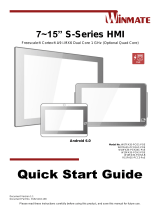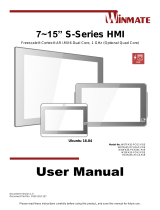
ARMPAC-5XX Series User Manual
Table of Contents
Revision History…………………………………………………………………………………………………….1
Warning!.............................................................…………………………….……………………2
Caution/Disclaimer...……………….......………………………………………………………………………3
Packing List…………………………………….…………………………………………………....................4
Safety Precautions………………………………….……………….…..……………………....................5
Chapter 1 Getting Started
1.1 Features……..…………………..………………………...…………………………..6
1.2 Specifications…..………………...………………………………………………….6
1.3 Dimensions……..…………………....……………………………………………...9
1.4 Brief Description of ARMPAC-5XX…..….…..……………………….……12
1.5 VESA Mounting……………….…………..………..…...…………………..…..13
1.6 Panel Mounting…..………….…………..………..…...…………………..…..13
Chapter 2 Hardware
2.1 Motherboard Jumpers Setting and Connectors…………………...14
Chapter 3 Installations
3.1 Update ARMPAC-5XX WEC7 Firmware............……………………...19
3.2 Update ARMPAC-5XX Linux Firmware.............……………………...20
Figures
Figure 1.1: Dimensions of ARMPAC-505....……………….…………………………...9
Figure 1.2: Dimensions of ARMPAC-507(P)..…….……….……………………….…..9
Figure 1.3: Dimensions of ARMPAC-508(P)………………… ……..………….…….10
Figure 1.4: Dimensions of ARMPAC-510(P) ………………………………………….10
Figure 1.5: Dimensions of ARMPAC-512(P)…..………………………………………11
Figure 1.6: Front View of ARMPAC-5XX Series………………………………………12
Figure 1.7: Rear View of ARMPAC-5XX Series…………………………………….…12
Figure 1.8: ARMPAC Series VESA Mounting.……..……………………………….…13
Figure 1.9: ARMPAC Series Panel Mounting……..…………………..……………..13























